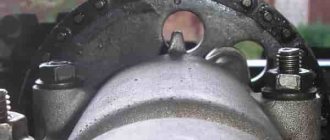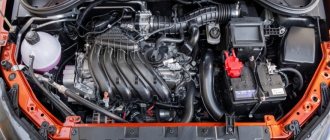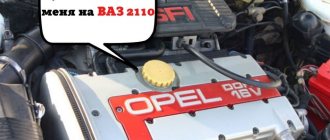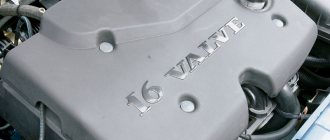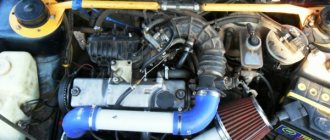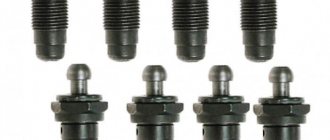Description
The VAZ-21179 engine, created and put into production in 2016, was significantly different from its predecessors. First of all, the increased working volume. The elements of the connecting rod and piston group, timing, lubrication and cooling systems have received significant changes.
The VAZ-21179 is a four-cylinder in-line naturally aspirated petrol engine with a volume of 1.8 liters and a power of 122-145 hp. s and torque 170-184 Nm.
Installed on VAZ cars:
- Lada Vesta 2180 and SV 2181 (2016-2021);
- Lada Vesta Cross 2180 (2018-2021);
- Lada Vesta Sport 2180 (2018-2021);
- Lada X-ray (2015-2021);
- Lada X-ray Cross (2018-2021).
Additionally, it was planned to install this engine on other VAZ models (Largus, Kalina-2, Granta and Lada 4x4 NG), but the projects were not implemented.
The cylinder block is traditionally made of cast iron. The basis for the development was a block from the VAZ-21126. The improvements included the manufacture of an additional oil channel for lubrication of the valve timing control, improved cooling of the inter-cylinder jumpers and changes in the fastening of the bracket for the right engine support.
The engine crankshaft has undergone changes. The crank radius was increased to 42 mm instead of the previous 37.8, which affected the piston stroke. Now it has become 84 mm (was 75.6). To reduce friction, the diameter of the connecting rod journals has been reduced by four millimeters.
The lubrication of the main bearings began to be carried out according to a new scheme.
The pistons are standard, aluminum, with three rings, two of which are compression, one oil scraper (chrome-plated).
The connecting rods are shortened and interchangeable. Delivered from India.
The cylinder head has received significant improvements. Camshafts (2 pcs.) – composite design. Pressed cams (powder metallurgy). A valve timing regulator (phase shifter) is mounted on the intake camshaft. The head is installed on a metal gasket.
The intake module has also been modified - instead of the mass air flow sensor, temperature and absolute pressure sensors have been installed. In addition, an additional receiver with a system for changing the length of the air path was removed from the design.
The cooling system uses a pump from a Korean manufacturer (GMB). Overall, engine cooling has become more efficient.
The lubrication system is slightly increased in volume and has an oil pump with increased performance (like a water pump - from GMB). Aluminum crankcase, cast.
A more complete list of changes is presented in the figure.
Main changes in the VAZ-21179 engine
Timing belt drive. The service life determined by the manufacturer is 180 thousand km. It must be remembered that if the drive belt breaks, the meeting of the valves with the piston is inevitable. The result is predictable - bent valves and a destroyed piston.
Despite innovative solutions in the design of internal combustion engines, the final result turned out to be far from what was planned, much less from the ideal.
The main “disease” of the engine is oil burning. There have been cases when it exceeded 3 liters. per 1000 km. mileage VAZ engine builders have repeatedly tried to solve this problem, but the attempts were unsuccessful.
Experts attribute the increased oil consumption to design flaws in the development of the power unit.
Firstly, the height of the cylinder block remained the same, but the connecting rods were shortened. As a result of this decision, the speed of movement of the pistons increased with a simultaneous increase in load.
Secondly, the quality of the valves is very low (they are supplied from China).
Thirdly, as a result of the manufacturer’s shortcomings, there are errors in the incorrectly designed lubrication scheme of the crankshaft-main liner assembly (the groove on the liner is less than 180°, and there are no counter grooves in the yokes at all).
Additionally, this may include the low quality of control during engine assembly (there are cases of increased gaps in the CPG).
The oil burn problem is eliminated by boring the block to the next repair size and replacing the pistons and rings. In other words, the engine needs a complete overhaul regardless of its mileage.
Peculiarities
In 2106, the VAZ 21179 1.8 engine was created and put into production, and at the same time it had a fairly large number of differences from its predecessors. Everyone immediately notices an increase in working volume. The ShPG parts, gas distribution mechanism, cooling and lubrication system have also received quite serious changes.
The engine is made in the usual configuration as a gasoline in-line engine with four cylinders without a turbine. This made it possible to guarantee the characteristics of the VAZ 21179 engine in the form of 122-145 horsepower. The maximum torque ranges from 170 to 184 Nm, depending on the year of manufacture.
Manufacturers initially planned to install this power unit also on other car models: Largus, Kalina-2, Granta and Lada 4x4 NG. But due to the prevailing circumstances, they were unable to implement this idea.
Already according to established tradition, the cylinder block was made of cast iron. As the basis for the development, the engineers used a block from the VAZ-21126 power unit. But the block was slightly modified by using an additional oil channel necessary to lubricate the valve timing regulator. In addition, the cooling of the jumpers between the cylinders has been improved. The fastening of the right engine mount bracket was also changed.
The internal combustion engine crankshaft has also undergone certain changes. In order to increase the piston stroke from 75.6 to 84 millimeters, manufacturers had to change the crank radius from 37.8 to 42 millimeters. In order to achieve optimal friction values, the diameter of the connecting rod journals was also reduced by 4 millimeters.
A new scheme was also used to lubricate the main bearings. The standard pistons are made of aluminum. Manufacturers installed two compression rings and one oil scraper ring with a chrome coating.
The connecting rods were reduced in length and interchangeable. The parts were supplied from India. A fairly large number of modifications are also observed in the cylinder head. Both camshafts have a composite design. The cams were made by pressing using powder metallurgy. The intake camshaft is the location for mounting the phase shifter (valve timing regulator). A metal gasket is installed between the head and the block.
There are also quite serious improvements in the intake module, since instead of a mass air flow sensor, a temperature and absolute pressure sensor are now being used. In addition, the design received relief in the form of the removal of an additional receiver with a system for changing the length of the air path.
The cooling system included the installation of a pump from GMB (Korean company). This made the entire system more efficient. The lubrication system also received an increase in volume. It is equipped with a high-performance oil pump, from the same manufacturer as the pump. The crankcase was cast from aluminum.
The gas distribution mechanism is driven by a belt. Manufacturers claim that the belt runs 180 thousand kilometers. But it is worth remembering that if the belt breaks, the valves of the VAZ 21179 engine will meet the pistons. The result is a destroyed piston along with bent valves.
Specifications
| Manufacturer | Concern "AvtoVAZ" |
| Start year of release | 2016 |
| Volume, cm³ | 1774 |
| Power, l. With | 122-145 |
| Torque, Nm | 170-184 |
| Compression ratio | 10.3 |
| Cylinder block | cast iron |
| Number of cylinders | 4 |
| Fuel injection order | 1-3-4-2 |
| cylinder head | aluminum |
| Cylinder diameter, mm | 82 |
| Piston stroke, mm | 84 |
| Number of valves per cylinder | 4 (DOHC) |
| Timing drive | belt |
| Turbocharging | No |
| Hydraulic compensators | There is |
| Valve timing regulator | VVT, 1 (intake) |
| Lubrication system capacity, l | 4.4 |
| Oil used | 5W30, 5W40, 10W30, 10W40 |
| Fuel supply system | injector |
| Fuel | gasoline AI-92 |
| Environmental standards | Euro 5 |
| Resource, thousand km | 220 |
| Location | transverse |
| Weight, kg | 110 |
| Tuning (potential), l. With | 150 |
Maintenance
Manufacturers stated that the resource of the power unit is 220 thousand kilometers, but with proper maintenance and appropriate care, you can travel 400 thousand kilometers without problems. But for this it is necessary to maintain the engine in a timely manner. New oil for the VAZ 21179 engine must be changed along with the filter every 10 thousand kilometers.
The alternator belt must be replaced after 30 thousand kilometers. Intervention into the cooling system in the form of replacing antifreeze is required after 45 thousand kilometers. It is recommended to check the spark plugs and battery after 60 thousand kilometers. The timing belt runs up to 180 thousand.
Reliability, weaknesses, maintainability
Reliability
The issue of reliability of the VAZ-21179 has always caused controversy among car owners. It was not possible to reach a common opinion.
The manufacturer has made several attempts to increase the reliability of the internal combustion engine. Unfortunately, they did not lead to the expected result. As noted, the main problem with this engine was high oil consumption. The main ways to solve this problem were chosen:
- changing the valve timing control calibration;
- contacting valve suppliers to improve the quality of supplied products;
- changes in the manufacturing technology of valve stem seals;
- replacing 5W30 oil with a more viscous one;
- changing the design of the oil deflector.
A huge amount of work has been done in these areas, but has yielded virtually no results. Car enthusiasts write about this in their comments on forums. So, Xotab_555 o. And such reviews are not isolated.
At the same time, it is noted that some engines lasted 300-350 thousand km without breakdowns or deviations in oil consumption. But, judging by the reviews, this applies to those engines that have undergone a major overhaul with the replacement of the piston group and boring of the cylinders.
The general conclusion is not comforting - the reliability of the VAZ-21179 engine is extremely low.
Weak spots
There are not so many of them, but they are significant. Increased oil consumption has already been mentioned. Another problem that often occurs in the lubrication system is the oil pump pressure relief valve jamming in the open position.
The main reason for the phenomenon is contamination of the working surface with combustion products and the use of contaminated oil.
Oil leaks through seals. Eliminated by replacing seals or gaskets. Sometimes it's enough just to tighten them a little more.
The occurrence of knocking noises when the engine is not warmed up. In most cases, the “authors” are hydraulic compensators. This is not fatal, but in this case it would not be superfluous to have the engine diagnosed at a specialized service station - there are many reasons for the appearance of knocking noises.
The electrics of the unit also cause a lot of complaints. Particularly annoying is the regular appearance of the “Check Engine” icon on the dashboard. Often, immediate computer diagnostics of the engine in this case does not detect any deviations in the operation of the engine systems.
Low quality of parts supplied for assembly by importers, especially from China.
Other malfunctions that sometimes occur in the unit are not critical.



